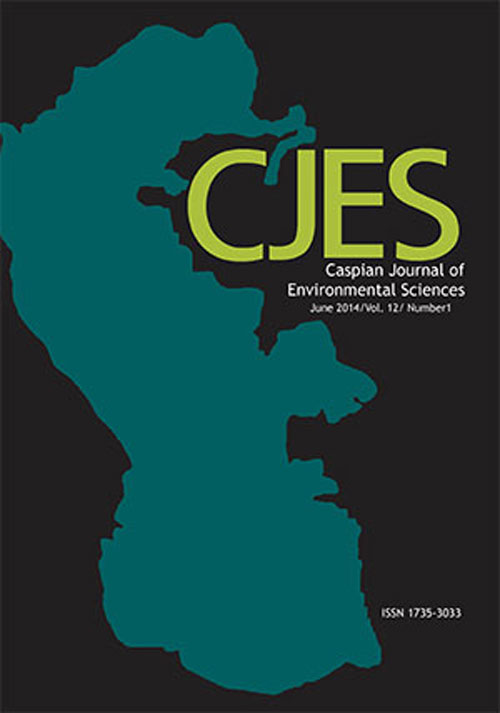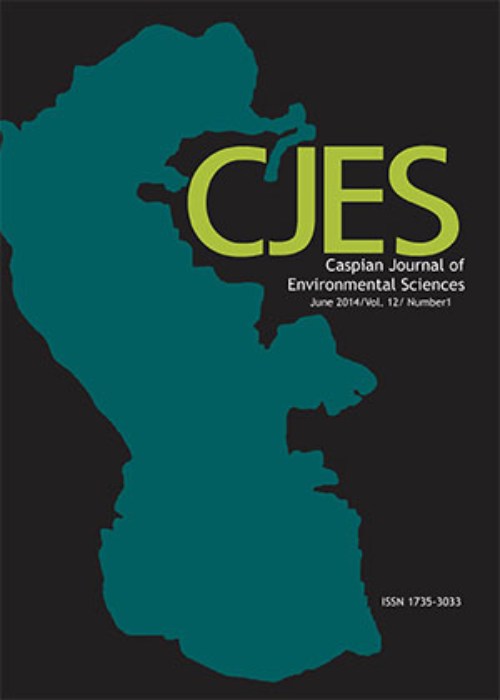فهرست مطالب

Caspian Journal of Environmental Sciences
Volume:14 Issue: 2, Spring 2016
- تاریخ انتشار: 1395/05/19
- تعداد عناوین: 8
-
-
Pages 95-103The karyotypic characteristics of chub, Squalius cephalus have been investigated by examining metaphase chromosomes spreads obtained from gill and kidney tissues. The fish used in the study were caught with fishing nets from Dumlu Stream, one of the main tributaries of the Karasu River. The live fish were transported to the laboratory, kept in a well aerated aquarium before analysis and then were injected intraperitoneally with doses of phytohemagglutinin, 0.01 ml.g-1 BW of 1% solution with 48-h interval to induce cell divisions. At the end of the period, the fish were injected intraperitoneally with doses of colchicine (0.01 ml.g-1 BW of 6% solution) and left for 3 hours before anesthesia and sacrificing. The best treatment parameters for preparing good metaphase chromosome spreads from the gill and kidney cells were performed as hypotonic (0.075 M KCl) treatment for 50 minutes, fixation with cold Carnoy solution at 3:1 ratio (methanol: acetic acid) and a concentration of 5% Giemsa for 35 minutes. The diploid chromosome number of this species was 2n = 50. The fundamental arm number (FN) was 92. The karyotypes were composed of 5 metacentric, 11 submetacentric, 5 subtelocentric and 4 acrocentric chromosome pairs (10 M 22 SM 10 ST 8 A). No sex chromosomes were cytologically detected in this fish.Keywords: Karyogram, Karasu Basin, Chromosomes, Fish
-
Pages 105-115Copper (Cu) is an essential element required by all living organisms, since at least 30 enzymes are known to use Cu as a cofactor. Cu is also toxic in excess and liver and gills are known to be target organs for it. In the present study, 240 Siberian sturgeon juvenile (with initial weight 29.2 ± 3.1 g and initial length 21.8 ± 1.4 cm) were randomly distributed in 12 fiberglass tanks at 4 different copper nanoparticle (Cu-NPs) treatments with 3 replicates. Treatments included control (T0 = no added Cu-NPs), 50 (T50), 100 (T100), 200 (T200) µg.l-1 Cu-NPs (mean primary particle size of 2 - 6 nm) in a semi-static waterborne exposure regime. Water exchanged were 20% daily with re-dosing after each change. The experimental period lasted 28 days, 14 days exposure to Cu-NPs and 14 days as recovery time. Fish liver, gill, intestine and muscle were sampled at days 0, 7, 14, 21 and 28. Samples were weighed, dried (100 ◦C for 48 h) then digested in concentrated nitric acid in a water bath, cooled, and analyzed for Cu concentration in the tissues with graphite furnace atomic absorption spectroscope. Most of the Cu-NPs were accumulated in the intestine, gill, liver and muscle. The accumulation of NPs in tissues was increased in all treatments from day 7 through 14. In the recovery period, Cu-NPs in tissues decreased but it was still higher than the control treatment. The current findings indicate that preventing the entry of Cu-NPs into the aquatic environment would seem to be essential.Keywords: Fish, Nanoparticles, Copper accumulation, Atomic absorption
-
Pages 117-124The effect of salting by different salt composition on fatty acid profile studied in hot smoked Black and Caspian Sea sprat, Clupeonella cultriventris. After initial prepare activities, samples were exposed to brining process within two salt concentrations including of 100 % NaCl (treatment 1 or T1) and 75 % NaCl- 25 % KCl (treatment 2 or T2) under 15% brine solution for 3 hrs. The smoking process included turning the samples into drying and hot smokes by slow and high rates of smoking machine (Atmoos) set and packaged. Fatty acid profiles of treated samples were compared with fresh fish samples (control). Smoking process decreased the content of SFA and contemporary increased the content of PUFA in comparison to control samples. These changes were slightly higher in T2. N-3/n-6 ratio of control samples (7.30) was increased in T1 samples (7.71) and decreased in T2 samples (6.86) after smoking process. Atherogenic index (AI) value was decreased after smoking process in both treatments with higher decrement for T2. Thrombogenic index (TI) value was also decreased after smoking process in both treatments. Partial sodium replacement did not affect fatty acid composition, PUFAs content, AI and TI values.Keywords: Clupeonella cultriventris, Fatty acid profile, Sodium replacement, Hot smoking
-
Pages 125-137This research develops an allometric model for estimation of biomass based on the height and DBH of trees in the Hyrcanian forests of Iran. An accurate allometric model reduces the uncertainty of allometric equation in biomass estimation using radar images. In this study, 317 trees were selected randomly from the 4 different dominant tree species for the development of an allometric model covering the wide range of DBH and height classes. The selected trees were measured by fieldwork in different parts and then volumes of these parts were calculated separately. Total volume of tree is obtained by the summation of these volumes. Twelve commonly used allometric models, three generalized models and a proposed model were tested and the most suitable model was selected based on some of the commonly measured statistical parameters including coefficient of determination (R2), Root-Mean-Square Error (RMSE) and Mean Error (ME). We showed that the biomass estimation accuracy was improved in a multilayer perceptron neural network (MLPNN) when density of wood, DBH and height were used in combination compared to estimating the biomass by current allometric models. The RMSE value was decreased when the proposed method was used (RMSE =0.163 Mg and R2=0.986) in comparison with Chave model, as the best current method (RMSE =0.404 Mg and R2=0.957) in this paper.Keywords: Allometric model, Biomass, DBH, Height, Hyrcanian forests, MLPNN
-
Pages 139-153Water is the main option of any development, so having an accurate management of groundwater is necessary. This study has been done in Damghan sedimentary plain in Iran, which is located in northwest of Semnan Province. The main objective of this research was to estimate the rate and right site of recharge in Damghan plain to prevent the aquifer from decreasing the water table. For this purpose, the monthly data of observation wells in a water year from September 2009 to August 2010 were prepared. Next, the type of aquifer, horizontal hydraulic conductivity (K), and the height of top and bottom layers were provided. Finally, the aquifer has been simulated by MODFLOW in two states: steady and transient. After simulation by application of different recharge rates, such as 11, 21 and 31 million cubic meter (MCM), it became clear that the fluctuation of water table on the southwest of the plain is less than the other areas, so it is considered as the right site of recharge. Meanwhile, the water table showed no significant change as a matter of recharge 11 and 31 MCM rates, but it displayed a considerable enhancement by adding 21 MCM recharge rate. Therefore, the study revealed that the appropriate rate of recharge is 21 MCM.Keywords: Damghan Plain, Water table, Simulation, Recharge
-
Pages 155-164The aim of this study was to assess the relative efficiency of the Iranian forest management plans using the non-parametric method Data Envelopment Analysis (DEA) as a well-known and robust technique for measuring the relative efficiency of organizations. The relative efficiency of forest management plans was calculated using the most frequency DEA models such as global technical efficiency (CCR), local pure technical efficiency (BCC) and Scale Efficiency (SE) on 12 units in Guilan Province, Iran. According to the results of CCR and BCC models, the efficiency averaged 0.83 and 0.93, respectively. The results of SE discussed a worrying aspect of these units efficiency; namely, there were only 3 efficient forest management plans (Shafaroud, Nav and Fiyab). However, the Scale Efficiency Index (SEI) brings out some interesting points; there were approximately 58% (7 units out of 12) under Increasing Returns to Scale (IRS). Therefore, the managers of forest management plans should focus more on the plans under IRS, so that they will have the opportunity to become more efficient through growth, otherwise managers will not be able to promote their overall productivity.Keywords: Data envelopment analysis, Measuring the performance, Returns to scale, Forest management plans
-
Pages 165-175There is a strong mutuality between tourism and environment via the creation of feedback mechanisms, since tourism often places adverse effects upon the quality and quantity of natural and cultural resources of the destination, leading to its qualitative and quantitative degradation. Within theEnvironmental Impacts Assessment (EIA) studies, various methods have been proposed to assess and analyze the environmental impacts. The Rapid Impact Assessment Method (RIAM) has been used in the present study to assess and analyze the environmental impacts of Karun Dam IV touristic area. The outcome of the study indicates that the developments in tourism can have considerable negative effects on the physical and biological parameters in construction and utilization phases. For the optimum utilization of the resources and facilities of the area throughout the year, and the amelioration of social welfare of the inhabitants and their ability to enjoy the auspices of tourism development, the touristic- developmental activities besides the Karun Dam IV should take place by the observation of environmental management programs. This will lead to considerable positive effects in the Southwestern Zagros area.Keywords: environmental impacts assessment, RIAM, tourism development, Karun Dam IV
-
Pages 177-185Rangelands renewable resources play a very important role in ecosystem regulating, preserving plant genetic reservoirs, water cycle as well as providing large parts of forage requirements. These resources were considered to be a basis for sustainable development and also a basic platform for various economic activities. During the recent years in Iran, these valuable sources were subjected to strong destruction due to the excessive exploitation and unethical of ranchers. Nowadays, it seems necessary to suggest appropriate grazing management programs, organizing systematic exploitation and preventing the destruction of rangelands. The aim of present study was to evaluate the role of educational and extension strategies in reducing rangelands destruction, grazing management and principally organization of its exploitation. Statistical community of the present study was Ilam Province, Iran. Sample size was calculated using Cochran formula as 255 ranchers and individuals were selected using Simple Randomized Sampling Method. Data were analyzed through Spearman correlation co-efficient and Mann Whitney U test using SPSS software. Results showed that there was no significant relationship between age, number of livestock and the use of educational and extension strategies related to reducing rangelands degradation but there was direct and significant relation of gender, education, participation of exploiters in educational and extension training courses and also adoption of educational and extension strategies relate d to reducing rangelands degradation.Keywords: Education, extension training courses, Sustainable, Exploitation, Rangelands


